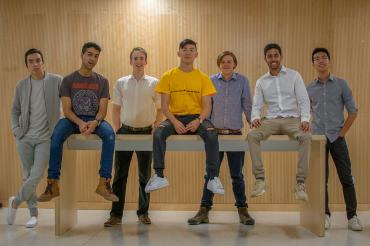U of T students create app for carpooling

Published: October 29, 2018
During his first year as a student at University of Toronto Scarborough, Peter Meng regularly spent $40 on gas to visit his girlfriend in Waterloo, Ont.
Frustrated with the high cost, he looked for an alternative and discovered Facebook groups where thousands of university students co-ordinate carpooling.
“My immediate question,” says Meng, “is why there wasn’t anything specializing in this?”
The Facebook groups didn’t eliminate what Meng saw as the main problems with carpooling: co-ordinating rides is tedious and there are too many drivers with no incentive to become riders.
So last summer Meng began developing Weav, an app to take the pain out of carpooling.
He soon entered The Hub, U of T Scarborough’s entrepreneurship incubator, where he connected with six other students and worked with director Gray Graffam to bring Weav to life. “I think they can actually hit this out of the park,” says Graffam. “This is a wonderful service for people.”
Meng’s team moved temporarily to the Hatchery, a U of T incubator with an engineering focus, where they spent this past summer developing a unique algorithm. (U of T has nine incubators across its three campuses for companies at various stages of development.)
The team’s goal was to make the app as simple as possible. To find a driver or rider, Weav users input their destination and preferred time of travel. The app sends an update when a match is made. Users can view information on the driver or rider and accept or decline the ride with a tap.
“There’s a beauty in the simplicity of the algorithm,” says Sean van Wyk, a third-year student in computer science and Weav’s project manager. “The matching process is really the core of the app.”
Matches are not dependent on the same start or end location – the app recognizes when riders are on a driver’s route. If there are too many drivers taking the same route, the app encourages drivers to become riders instead.
“Our vision for the Toronto area would be to fill every empty seat on the road,” says Brady Vallbacka, a fourth-year student in management and information technology, and Weav’s marketing operations specialist. “If we could do that, we could solve a lot of traffic problems.”
Weav tracks users’ locations, then sends payment through the app once riders and drivers reach their destination. Drivers set the fee, but Weav encourages them to charge only enough to cover expenses such as gas and insurance.
Location tracking is part of the app’s safety features, along with tools that allow users to report terms-of-use violations such as damaging a car.
The name Weav is a play on the idea of weaving through traffic and a reference to bringing people together. Imagine, van Wyk says, several people who meet through Weav because they are going to the same hockey game. “It provides a lot of value and a lot of ways for people to actually connect.”
While the team members initially targeted long-distance journeys, they began looking at commuting after Vallbacka learned that many U of T co-op students won’t travel between east and west campuses, even if it means having a greater number of placements to choose from.
“I guarantee there’s one student doing that commute every day and they probably have four empty seats,” he says. “If they could get connected easily, they’d have more job opportunities.”
Weav created a “scheduled commute” feature to help connect these students and other regular travellers. The team is working to release a prototype of the app by early next year.



